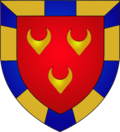Roeser
| coat of arms | map |
|---|---|

|

|
| Basic data | |
| State : |
|
| Coordinates : | 49 ° 32 ' N , 6 ° 9' E |
| Canton : | Esch on the Alzette |
| Residents : | 6459 (January 1, 2019) |
| Area : | 23.8 km² |
| Population density : | 271.4 inhabitants / km² |
| Municipality number: | 0211 |
| Website: | www.roeser.lu |
| politics | |
| Mayor: | Tom Boys ( LSAP ) |
| Elective system : | Proportional vote |
Roeser ( Luxembourgish Réiser ) is a municipality in the Grand Duchy of Luxembourg and belongs to the canton of Esch an der Alzette .
Composition of the community
The municipality of Roeser consists of the following localities:
- Berchem,
- Bivingen ,
- Crauthem,
- Kockelscheuer ,
- Livingen,
- Pepping,
- Roeser.
history
Human settlement in the Roeser Valley has been proven by tool finds since the Stone Age. Archaeological finds from the Bronze Age and Iron Age indicate an increasingly dense population. Traces of at least five large villas have been preserved from Roman times.
The name Roeser first appeared in the 7th century.
politics
The project of a shopping center and national football stadium, which was planned as a public-private partnership on a plot of land in Livange that had previously been designated as undeveloped green space, was controversial . The project was strongly rejected by the Mouvement écologique in particular . In the first half of 2012, the citizens of the municipality were supposed to cast their vote in a referendum on this question, which ultimately did not take place after the government announced that it would abandon the project for budgetary reasons.
The municipality is a member of the following municipal associations: Minett-Kompost, SES, SICEC, SICONA, SIDOR, SIGI, SPIC, STEP, SYCOSAL, SYVICOL.
The municipality has a partnership with Turi in Italy .
Pepping Farm Museum
Around the year 2000, a large slag dump from the 7th or 8th century was found in the Genoeserbësch des Peppinger Bann, which turned out to be the basis of a racing furnace . The iron smelting plant was reconstructed according to old models and copied in the forest forge of the Peppinger Bauernmuseum, which had been completely excavated by employees of the University of Münster . According to history professor Norbert Quintus, curator of the museum, the slag was analyzed in its composition; the Musée de l'histoire du fer found out that the iron producers at the time had used both minette and rich ore , which probably came from the area around Dudelange or Rümelingen . Since temperatures of only about 1100 degrees were achieved in the racing furnace used at that time, the iron was extracted as a rag ; After piercing the oven, this had to be heated again in a so-called "fresh oven" and then worked on a stone anvil with a hammer. The iron obtained in this way could then be processed into tools or weapons. Such an attempt with the replica racing furnace was successfully undertaken by the friends of history from the Roeserbann and the Brotherhood of Hephaistos (Luxembourg art blacksmiths association ).
Other cultural assets
literature
- Michael Overbeck: The medieval ironworks from the Genoeserbusch near Peppange (13th / 14th century). In: musee-rural.lu. 2007 .
- Michael Overbeck: To the roots of the iron industry in Luxembourg - Part I: Discovered a form of wind that is unique in Europe. (pdf, 969 kB) In: Hephaistos. 7/8, 2004, pp. 14-16 (reproduced on the website of the University of Münster).
- Michael Overbeck: To the roots of the iron industry in Luxembourg - Part II: From the stick to the bar. (pdf, 2.24 MB) In: Hephaistos. 9/10, 2004, pp. 42–43 (reproduced on the website of the University of Münster).
Web links
- Website of the municipality of Roeser
- Schools in the community of Roeser
- Museum of farmers and crafts, blacksmiths and metallurgy, Musée de Calèches Grande-Duchesse Charlotte carriage museum in Peppingen.
Individual evidence
- ↑ STATEC Luxembourg - Population par canton et commune 1821–2019 (French)
- ↑ Suddenly it should also be smaller. In: Lëtzebuerger Journal . January 4, 2012, archived from the original on August 4, 2012 ; accessed on July 2, 2019 .
- ↑ Critics consider the stripped-down version not enough. In: Tageblatt . January 4, 2012, accessed July 2, 2019 .
- ↑ R .: An experiment with the racing furnace. In: Tageblatt , May 12, 2003.

